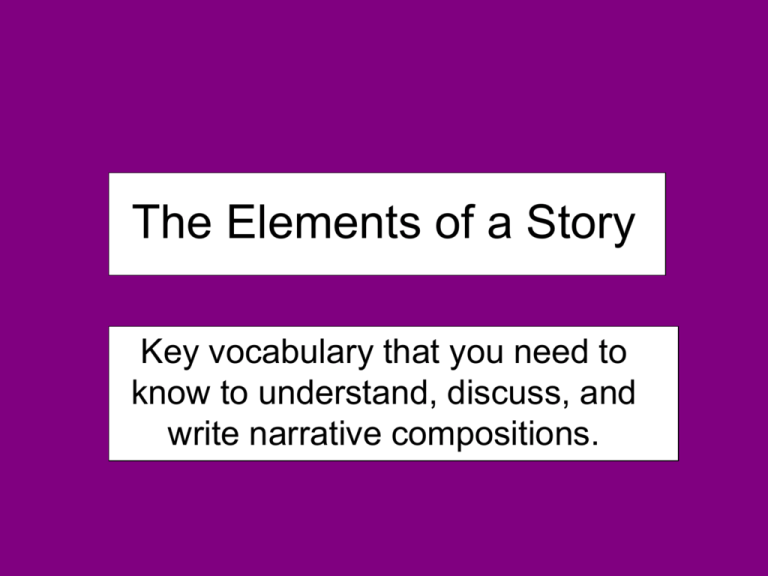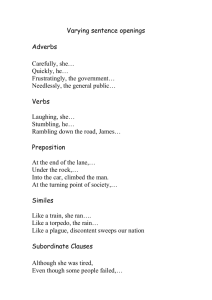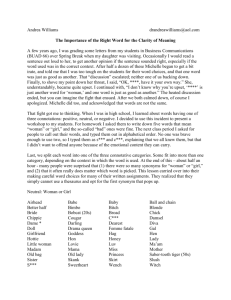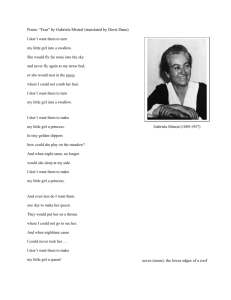The Elements of a Story - meyers
advertisement

The Elements of a Story Key vocabulary that you need to know to understand, discuss, and write narrative compositions. Character • A character is known through action, speech, and appearance. ‘He was a small boy, with glasses and hair that would never stay combed. On his forehead was a scar in the shape of a lightning bolt, a mark of both his deadly past and his heroic future.’ Protagonist: central character Antagonist: force in conflict with the protagonist (society--an idea like individuals are bad_ “1984”, nature--a hurricane_ “The Perfect Storm”, fate--being a wizard_ “Harry Potter”, self--deciding right from wrong_ “Hamlet”) Setting • The place and time in which the story takes place. • England, both a house in the real world and a magic school • Present day Plot • Sequence of events that involves the characters in conflict. • introduce the characters • conflict occurs • conflict is resolved • Harry Potter is a young boy unhappy in his life. • Harry discovers he is a wizard and goes to a magic school where a dark wizard tries to kill him. • Harry is able to defeat the dark wizard with the help of his friends. Plot -- Summary • summary: a part in a story that tells about a long time or a lot of information in a very un-detailed way; there is usually no dialogue and we are not there with the characters Mark and I had to go to school during the summer because we had failed our maths class the previous year. It was incredibly hot and everyday before class, we would sit in the lunchroom and I had to listen to Mark complain about wanting to be somewhere else. Plot -- Scene • scene: a part of a story where we are in the moment; we know where we are, when, there is dialogue, and immediate action We were sitting in the lunchroom, sweating in the hot summer air. “Why are we here during our vacation?” asked Mark. “Because we failed maths, dummy,” I replied. “Well, I don’t want to be here,” Mark said. “Let’s skip out and go to a movie.” Point of View (POV) • Depends on who the narrator (the voice) is and how much he or she knows. • 1st person: uses “I”, a character is telling the story • 2nd person: uses “you”, the author is talking to the reader, usually used in non-fiction and directions • 3rd person: uses “he, she, it”, the author is talking about the characters Figurative Language • Language that gives the words a meaning beyond their actual one. • simile: a comparison of two things using ‘like’ or ‘as’ • Her eyes were like diamonds. • metaphor: a comparison of two things without using ‘like’ or ‘as’ • He was a dog – always chasing after girls. • personification: giving a non-human thing humanlike qualities • The leaves danced across the yard in the wind. Figurative Language cont. • onomatopoeia: naming a thing by the sound it makes • The bees buzzed loudly in their hives. • hyperbole: an extreme exaggeration • I have a mountain of homework to do. • imagery: descriptive language that involves the senses • The rich cake filled the air with the smell of chocolate happiness and heaven. • symbolism: when an object represents something more than what it is • When she saw the flag, she was reminded of courage and honor. Figurative Language cont. • euphemism: an inoffensive expression used in place of a blunt one • His father passed away. (died) •She is a bit slow. (not that smart) • cliché: something that has been overused to the point of annoyance, where it has lost its uniqueness • I have a mountain of homework to do. Cliché • A nerdy girl who goes through a makeover, usually involving removing her glasses, and she suddenly is gorgeous • Stupid jock likes girl; girl likes jock; girl’s best friend (a boy) is sensitive and understanding and likes girl; jock treats girl bad; girl realizes best friend is man for her Style • The types of language used in a book. • casual____The Twilight series “Charlie frowned. ‘Some of these places are pretty pricey, Bells. I want to help. You don’t have to go all the way to Alaska just because it’s cheaper.” • formal____”Pride & Prejudice” “Good heavens,” cried Elizabeth; “but how could that be? How could his will be disregarded? Why did you not seek legal redress?” Theme • The underlying meaning of the story • an important statement about life -- doesn’t relate only to story but also to life • ‘With the help of friends, good can defeat evil.’ Tone • The author’s attitude toward what he or she writes – Humor – Anger – Respect Different ways to open a story • • • • • • A. Middle of the action B. Setting the scene / atmosphere C. Introducing the main character D. Middle of the dialogue E. Shock (unexpected) F. Intrigue (mystery) Middle of the action • The house shook, the windows rattled, a framed photograph slipped off the shelf and fell in to the hearth. Setting the scene / atmosphere • It was a bright cold day in April, and the clocks were striking thirteen. Introducing the main character • Brian Grayson was a forty-five year old tax accountant that had never missed a day of work in his life. Middle of the dialogue • “Wait!” I shouted. “It is going to cost how much?” Shock (unexpected) • “Are you going to burn your mother’s body, Will?” asked Teddy. Intrigue (mystery) • So, the old woman was dead at last. Write freely for 5 minutes on ONE of the following topics… Flight Delay Beach Fun The New Kid The Big Game Blizzard Death








